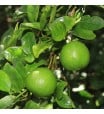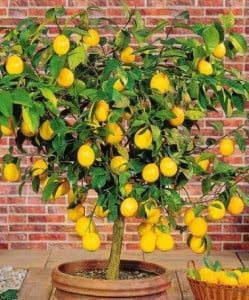 Small citrus trees grow very well in northern greenhouses. In my Rhode Island greenhouse, I grow lemons, limes, and oranges that I harvest during winter. The Key limes are especially favored for making Key lime pie. I even have a kaffir lime tree, the leaves of which I use with lemon grass when cooking a Thai dinner. In spring, when my citrus trees come into flower, their fragrance is delightful. Like shoppers waiting for the store to open on a sale day, bees clamor at my springtime greenhouse door waiting to get to the citrus flowers.
Small citrus trees grow very well in northern greenhouses. In my Rhode Island greenhouse, I grow lemons, limes, and oranges that I harvest during winter. The Key limes are especially favored for making Key lime pie. I even have a kaffir lime tree, the leaves of which I use with lemon grass when cooking a Thai dinner. In spring, when my citrus trees come into flower, their fragrance is delightful. Like shoppers waiting for the store to open on a sale day, bees clamor at my springtime greenhouse door waiting to get to the citrus flowers.
Warmth is critical to successfully growing citrus trees in a greenhouse during winter. I find that a minimum nighttime temperature of about 50o F is the best compromise between the cost of heating and the right amount of warmth to prevent the trees from dropping their leaves. At 50o, growth slows but doesn’t quite stop.
Even during winter, citrus trees require a little fertilizer. I begin with a half-strength solution and add a dose of chelated iron as needed. Citrus plants grown in containers seldom get enough iron. When they don’t, their leaves turn yellow. By adding iron to their diet, the leaves remain green. Watering and fertilizing requirements are greatest from spring until fall. At this time of year, my citrus trees are watered almost daily and fertilized weekly.
The yields from greenhouse citrus trees can be impressive. Don’t be concerned about 90% of the tiny fruits emerging from the flowers falling off. You’ll still have more fruit than you need in most cases. One year I had so many Key limes on my eighteen-year old, seven-foot-tall tree that my sons told me not to bother making any more Key Lime pies. Another year, my orange tree produced enough oranges to make a batch of marmalade. That’s how prolific these trees can be, even in Rhode Island!
 I move my citrus trees outdoors for the summer and back into the greenhouse in the fall. Picking the right time for the spring move to the patio can be tricky. Flowering needs to have almost ceased (although it will go on all summer), and the outdoor temperatures must be suitable. I’ve found that the best time is when the nighttime temperature outside is reliably above 55o F. In the move through the greenhouse door, care must also be taken not to knock off the emerging fruit. This challenge is even greater when the trees, laden with large fruit, are brought back into the greenhouse in the fall. If you are not extremely careful when passing through the door, you can inadvertently knock off up to a bushel of your crop. But when proper care is taken and the trees are safely back indoors, they will winter over in your greenhouse and be ready for another year of flowering and fruiting come springtime.
I move my citrus trees outdoors for the summer and back into the greenhouse in the fall. Picking the right time for the spring move to the patio can be tricky. Flowering needs to have almost ceased (although it will go on all summer), and the outdoor temperatures must be suitable. I’ve found that the best time is when the nighttime temperature outside is reliably above 55o F. In the move through the greenhouse door, care must also be taken not to knock off the emerging fruit. This challenge is even greater when the trees, laden with large fruit, are brought back into the greenhouse in the fall. If you are not extremely careful when passing through the door, you can inadvertently knock off up to a bushel of your crop. But when proper care is taken and the trees are safely back indoors, they will winter over in your greenhouse and be ready for another year of flowering and fruiting come springtime.


